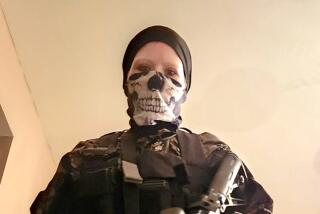Fear a Mad Loner More Than Saddam
- Share via
The recent confrontation with Iraq over its secret chemical and biological weapons development programs has renewed concerns about chemical and biological terrorism. What if a government like Saddam Hussein’s in Baghdad clandestinely used such weapons against its enemies, making it appear as if it were a terrorist attack? Or, might it turn over cruder versions of its deadly stocks to actual terrorist groups? In an environment that constantly features chemical and biological warfare in the headlines, might terrorists on their own be inspired to mass murder?
The danger is clearly there. State-sponsored terrorism is a reality, and terrorism has grown deadlier. But a closer inquiry into their decision-making reveals that both state and terrorist foes face difficulties and constraints: The critical calculation is not what quantity of poison gas or deadly germs may be required to depopulate a city, but weighing the chances of success against the risks of discovery and massive retaliation. The bigger danger to society may come from those tiny groups and deranged individuals who can’t or won’t make such calculations.
Over the past quarter of a century, there have been numerous small-scale incidents in which crackpots, criminals and political extremists have used or threatened to use chemical or biological agents. The most frequent were threats made by extortionists who targeted public water supplies, food and beverages. There have been hundreds of these acts, few of them fatal. The tactic was adopted by some political extremists who sought to use such threats as a mode of economic warfare against their state foes.
In only a handful of incidents was the large-scale indiscriminate use of chemical or biological agents carried out. Members of the Jonestown cult committed mass murder-suicide using cyanide-laced Kool-Aid. The Rajneesh cult in Oregon plotted to poison food at restaurants with salmonella to make townspeople ill on the day of a crucial referendum to decide the fate of their temple. The World Trade Center bombers packed their bomb with cyanide in sufficient quantity to contaminate the entire structure (the chemical was destroyed in the bomb blast). And members of the Aum Shinrikyo cult, fearing imminent police action, released nerve gas in Tokyo’s subways.
Notably, all four of these incidents involved religious motivations. There is little evidence that secular terrorists have taken anything other than a modest interest in chemical or biological agents, although more terrorists now are talking about them.
Conventional weapons now provide terrorists with the capacity to kill far more people than they have killed if mass murder were their objective. Most acts of terrorism involve only symbolic violence. Fewer then 30% involve fatalities; very few have involved mass murder. It is hard to kill a lot of people at one time, but technical difficulty is not the entire explanation. There are self-imposed constraints.
Wanton murder could tarnish a group’s image, imperil the group’s cohesion, alienate perceived constituents and provoke crackdowns that the group might not survive. But there is evidence that these constraints are eroding as ethnic hatreds and religious fanaticism replace ideological and political causes as the engines of armed conflict. Ethnic hatreds lend themselves to genocidal strategies; the constraints imposed by a political cause do not apply to those who believe they act for God. Large-scale violence has become today’s terrorist reality as terrorists increasingly seek a body count.
Chemical or biological terrorism seems more likely to emerge from the fringes, from the splinters of groups, from small ad hoc conspiracies, from mad religious cults. Hard to detect in advance, these single-cell plots are seldom capable of sustaining campaigns of terrorism, but they are capable of carrying out isolated spectacular acts like the World Trade Center or Oklahoma City bombings or a limited attack involving crude chemical or biological weapons.
An assessment of the threat must also take into account the disaffected and often mentally disturbed loner. Although the popular image of the brilliant lunatic manufacturing chemical or biological weapons in his garage is an exaggerated caricature, it cannot be dismissed. Twenty-three years ago, the “Alphabet Bomber” began a terrorist campaign with a deadly attack at Los Angeles International Airport. At the time of his arrest, the bomber was on the verge of manufacturing nerve gas.
More to Read
Sign up for Essential California
The most important California stories and recommendations in your inbox every morning.
You may occasionally receive promotional content from the Los Angeles Times.













